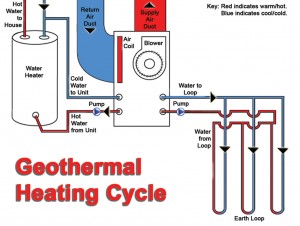How Does it Work?
Half of the sun’s energy is stored in the crust of the earth like a solar battery, and once an earth loop is placed below the frost line where the earth temperature doesn’t vary, it will be able to absorb heat in the winter and reject heat in the summer. In Minnesota at 6 to 8 feet underground the earth’s temperature is always a stable 48-52F. So even in Minnesota’s harsh winter climate, the earth below the frost line remains constant, providing you with as much heat needed to heat your home or building.

Geothermal heat pumps can be categorized as having closed or open loops, and the closed loops can be installed in three ways: horizontally, vertically, or in a pond/lake. The type chosen depends on the available land areas and the soil and rock type at the installation site. These factors will help determine the most economical choice for installation of the ground loop.
For closed loop systems, water or antifreeze solution is circulated through plastic pipes buried beneath the earth’s surface. During the winter, the fluid collects heat from the earth and carries it through the system and into the heat pump. The heat pump then converts that energy into usable heat through the refrigeration process. During the summer, the system reverses itself to cool the building by pulling heat from the building, carrying it through the system and placing it in the ground. This process creates free hot water in the summer and delivers substantial hot water savings in the winter.
 Open loop systems operate on the same principle as closed loop systems and can be installed where an adequate supply of suitable water is available and open discharge is feasible. Benefits similar to the closed loop system are obtained.
Open loop systems operate on the same principle as closed loop systems and can be installed where an adequate supply of suitable water is available and open discharge is feasible. Benefits similar to the closed loop system are obtained.
Here is a general overview of all the great benefits that geothermal heat pumps can offer its owners:
- Renewable Energy – Comes from the Sun
- Environmentally friendly – saving energy plus less raw materials needed to produce the product, plus all ground source heat pumps are now using the non-ozone depleting R-410a refrigerants, and they contain less of it than conventional AC systems.
- Energy Savings on heating, cooling and hot water – more dollars in consumer’s pockets
- Longer lasting – both the heat pump (20+) located in the home and the underground-buried loop system (200+) will last much longer than other conventional systems
- Quieter operation – no outdoor AC or ASHP unit
- Safe – all electric system (no combustion)
- Less maintenance – only the air filter that is associated with the heat pump (other HVAC items may require regular maintenance like humidifiers, HRVs, etc.)
- More reliable – located indoors with less moving parts
- Better comfort – longer run times mean more mixing of the air within the home that evens temperatures within all the rooms – warmer supply air temperatures than ASHPs.
- Aesthetics of the home – no flues, chimneys, gas meters, LP tanks, or outdoor AC units.
- Better life cycle cost and ROI than any other market technology
- Reducing Energy Dependency – Helps become less dependent on foreign oil & foreign natural gas


